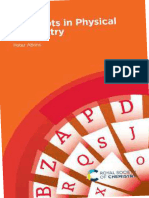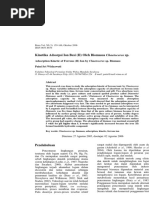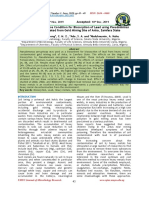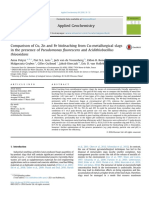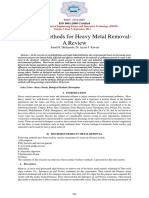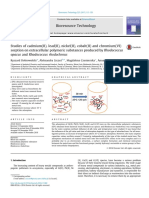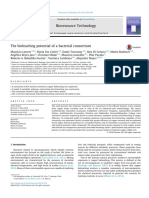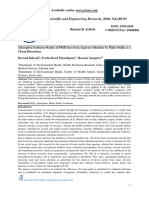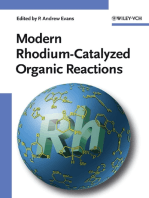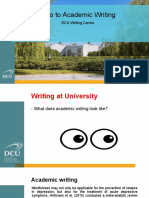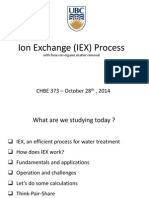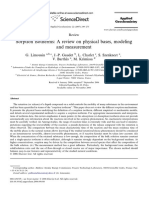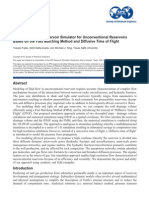Hypocrea Lixii
Hypocrea Lixii
Uploaded by
Windah AnisyahCopyright:
Available Formats
Hypocrea Lixii
Hypocrea Lixii
Uploaded by
Windah AnisyahOriginal Title
Copyright
Available Formats
Share this document
Did you find this document useful?
Is this content inappropriate?
Copyright:
Available Formats
Hypocrea Lixii
Hypocrea Lixii
Uploaded by
Windah AnisyahCopyright:
Available Formats
Biosynthesis and Uptake of Copper Nanoparticles by
Dead Biomass of Hypocrea lixii Isolated from the Metal
Mine in the Brazilian Amazon Region
Marcia R. Salvadori1*, Luiz F. Lepre2, Rômulo A. Ando2, Cláudio A. Oller do Nascimento3,
Benedito Corrêa1
1 Departamento de Microbiologia, Instituto de Ciências Biomédicas II, Universidade de São Paulo, São Paulo, São Paulo, Brazil, 2 Departamento de Quı́mica Fundamental,
Instituto de Quı́mica, Universidade de São Paulo, São Paulo, São Paulo, Brazil, 3 Departamento de Engenharia Quı́mica, Politécnica, Universidade de São Paulo, São Paulo,
São Paulo, Brazil
Abstract
A biological system for the biosynthesis of nanoparticles (NPs) and uptake of copper from wastewater, using dead biomass
of Hypocrea lixii was analyzed and described for the first time. The equilibrium and kinetics investigation of the biosorption
of copper onto dead, dried and live biomass of fungus were performed as a function of initial metal concentration, pH,
temperature, agitation and inoculum volume. The high biosorption capacity was observed for dead biomass, completed
within 60 min of contact, at pH 5.0, temperature of 40uC and agitation speed of 150 rpm with a maximum copper
biosorption of 19.0 mg g21. The equilibrium data were better described using the Langmuir isotherm and kinetic analysis
indicated that copper biosorption follows a pseudo-second-order model. The average size, morphology and location of NPs
biosynthesized by the fungus were determined by scanning electron microscopy (SEM), energy dispersive X-ray
spectroscopy (EDS) and transmission electron microscopy (TEM). NPs were mainly spherical, with an average size of
24.5 nm, and were synthesized extracellularly. The X-ray diffraction (XRD) analysis confirms the presence of metallic copper
particles. Infrared spectroscopy (FTIR) study revealed that the amide groups interact with the particles, which was
accountable for the stability of NPs. This method further confirmed the presence of proteins as stabilizing and capping
agents surrounding the copper NPs. These studies demonstrate that dead biomass of Hypocrea lixii provides an economic
and technically feasible option for bioremediation of wastewater and is a potential candidate for industrial-scale production
of copper NPs.
Citation: Salvadori MR, Lepre LF, Ando RA, Oller do Nascimento CA, Corrêa B (2013) Biosynthesis and Uptake of Copper Nanoparticles by Dead Biomass of
Hypocrea lixii Isolated from the Metal Mine in the Brazilian Amazon Region. PLoS ONE 8(11): e80519. doi:10.1371/journal.pone.0080519
Editor: Katerina Kourentzi, University of Houston, United States of America
Received July 17, 2013; Accepted October 14, 2013; Published November 25, 2013
Copyright: ß 2013 Salvadori et al. This is an open-access article distributed under the terms of the Creative Commons Attribution License, which permits
unrestricted use, distribution, and reproduction in any medium, provided the original author and source are credited.
Funding: This work was supported by the Fundação de Amparo à Pesquisa do Estado de São Paulo (FAPESP grant 2010/52305-1). The funders had no role in
study design, data collection and analysis, decision to publish, or preparation of the manuscript.
Competing Interests: The authors have declared that no competing interests exist.
* E-mail: mrsal@usp.br
Introduction fungi have been used in bioremediation processes since they are a
versatile group that can adapt to and grow under extreme
Recently, the synthesis of inorganic nanoparticles has been conditions of pH, temperature and nutrient availability, as well as
demonstrated by many physical and chemical means. However, at high metal concentrations [6]. Consequently, there has been
the importance of biological synthesis is being emphasized globally considerable interest in developing biosynthesis methods for the
at present because chemical methods are capital intensive toxic, preparation of copper NPs as an alternative to physical and
non-ecofriendly and have low yield [1]. Copper NPs, due to their chemical methods. Literature review of previous studies revealed
unique physical and chemical properties and low cost of that few articles were published on the biosynthesis of copper NPs
preparation, have been of great interest recently. Furthermore, [1]. We can mention some examples as Hassan et al.[7], Honary et
copper NPs have potential industrial use such as gas sensors, al. [8], Ramanathan et al. [9], Singh et al. [10], but none of these
catalytic processes, high temperature superconductors, solar cells studies used the fungus Hypocrea lixii (H. lixii). Also, most of the
and so on [2–3]. New alternatives for the synthesis of metallic NPs biosynthesis studies on copper NPs focused on bioreduction phase
are currently being explored through bacteria, fungi, yeast and only, but not the important biosorption phase of the process.
plants [4]. Wastewater from copper mines often contain a high Microbial systems have found an important role in NPs
concentration of this toxic metal generated during its extraction, production due to their natural mechanism for detoxification of
beneficiation, and processing. In recent years, bioremediation, metallic ions through bioreduction, being one of the primary
through the biosorption of toxic metals as copper has received a process of biosynthesis, that can be achieved extracellularly,
great deal of attention, not only as a scientific novelty, but also through biosorption [11]. Therefore, the study of biosorption
because of its potential industrial applications. This novel coupled to the process of bioreduction offers advantages as the
approach is competitive, effective, and cheap [5]. In this respect, optimization of physico-chemical parameters (pH, temperature,
PLOS ONE | www.plosone.org 1 November 2013 | Volume 8 | Issue 11 | e80519
Biosynthesis of Copper Nanoparticles by H. lixii
Figure 1. Batch biosorption studies. Influence of the physico-chemical factors on the live, dried and dead biomass of H. lixii. (A) Effect of the
amount of biosorbent. (B) Effect of pH. (C) Effect of temperature. (D) Effect of contact time. (E) Effect of agitation rate. (F) Effect of initial copper
concentration.
doi:10.1371/journal.pone.0080519.g001
metal concentration, interaction time and others) that govern the offers a more holistic view of the biosynthesis. In order to enlarge
biosorption providing an increase in biosynthesis process efficien- the scope of biological systems for the biosynthesis of metallic
cy. It also makes it a potential industrially scalable process, and nanomaterials and bioremediation of wastewater, we explored for
PLOS ONE | www.plosone.org 2 November 2013 | Volume 8 | Issue 11 | e80519
Biosynthesis of Copper Nanoparticles by H. lixii
Figure 2. Biosorption isotherm models and biosorption kinetics of H. lixii. Langmuir plots for live (A), dried (B) and dead (C) biomass. Pseudo
second-order models for live (D), dried (E) and dead (F) biomass.
doi:10.1371/journal.pone.0080519.g002
PLOS ONE | www.plosone.org 3 November 2013 | Volume 8 | Issue 11 | e80519
Biosynthesis of Copper Nanoparticles by H. lixii
the first time in this work the potential of the fungus H. lixii, to the biomass was autoclaved. The dried biomass was obtained through
uptake and reduction of copper ions to copper NPs. Thus, the drying of the fungal mat at 50uC until it became crispy. The dried
bioremediation and green synthesis of copper NPs has been mat was ground to obtain uniform sized particles.
achieved in the present study using dead biomass of H. lixii. The pH (2–6), temperature (20–60uC), contact time (5–
360 min), initial copper concentration (50–500 mg L21), and
Materials and Methods agitation rate (50–250 rpm) on the removal of copper was
analyzed. Such experiments were optimized at the desired pH,
Ethics Statement temperature, metal concentration, contact time, agitation rate and
The company Vale S.A., owner of Sossego Mine, located in biosorbent dose (0.15–1.0 g) using 45 mL of 100 mg L21 of Cu
Canaã, Pará, in the Brazilian Amazon region, through the director (II) test solution in plastic flask.
of the Vale Technology Institute, Dr Luiz Eugenio Mello Several concentrations of copper (II) were prepared by
authorizing the establishment and dissemination of the study appropriate dilution of the copper (II) stock solution. The pH
featured in this research article, allowing the collection of material was adjusted with HCl or NaOH. The desired biomass dose was
(water from pond of copper waste) supervised by company then added and the content of the flask was shaken for the desired
employees, whose material led to the isolation of the fungus under contact time in an electrically thermostatic reciprocating shaker at
study. This field study did not involve manipulation of endangered the required agitation rate. After shaking, the Cu (II) solution was
or protected species by a government agency. separated from the biomass by vacuum filtration through a
Millipore membrane. The metal concentration in the filtrate was
Growth and maintenance of the organism determined by flame atomic absorption spectrophotometer (AAS).
H. lixii was isolated from the water collected from a pond of The efficiency (R) of metal removal was calculated using the
copper waste from Sossego mine, located in Canãa dos Carajás, following equation:
Pará, Brazilian Amazonia region (06u 269 S latitude and 50u 49 W
longitude). H. lixii was maintained and activated on Sabouraud
R~(Ci {Ce )=Ci :100
Dextrose Agar (SDA) (Oxoid, England) [12].
where Ci and Ce are initial and equilibrium metal concentrations,
Minimum inhibitory concentration in agar medium respectively. The metal uptake capacity, qe, was calculated using
Copper tolerance of the isolated fungus was determined as the the following equation:
minimum inhibitory concentration (MIC) by the spot plate
method [13]. SDA plates containing different copper concentra-
tions (50 to 2000 mg L21) were prepared and inocula of the tested qe ~V (Ci {Ce )=M
fungus were spotted onto the metal and control plates (plate
where qe (mg g21) is the biosorption capacity of the biosorbent at
without metal). The plates were incubated at 25uC for at least 5
any time, M (g) is the biomass dose, and V (L) is the volume of the
days. The MIC is defined as the lowest concentration of metal that
solution.
inhibits visible growth of the isolate.
Sorption isotherm and kinetics models
Studies of the effects of physico-chemical factors on the
Biosorption was analyzed by the batch equilibrium technique
efficiency of adsorption of copper NPs by the biosorbent using the following sorbent concentrations of 50–500 mg L21. The
All chemicals used in the present study were of analytical equilibrium data were fit using Freundlich and Langmuir isotherm
grade and were used without further purification. All dilutions models [14]. The linearized Langmuir isotherm model is:
were prepared in double-deionized water (Milli-Q Millipore
18.2 Vcm21 conductivity). The copper stock solution was
prepared by dissolving CuCl2.2H2O (Carlo Erba, Italy) in Ce =qe ~1=(qm :b)zCe =qm
double-deionized water. The working solutions were prepared
by diluting this stock solution. where qm is the monolayer sorption capacity of the sorbent (mg
The fungal biomass was prepared in Sabouraud broth (Sb) g21), and b is the Langmuir sorption constant (L mg 21). The
(Oxoid, England), and incubated at 25uC for 5 days, at 150 rpm. linearized Freundlich isotherm model is:
After incubation, the pellets were harvested and washed with of
double-deionized water this was referred to as live biomass. For Inqe ~InKF z1=n:InCe
the preparation of dead biomass, an appropriate amount of live
Table 1. Adsorption constants from simulations with
Langmuir and Freundlich models. Table 2. Kinetic parameters for adsorption of copper.
Langmuir model Freundlich model Pseudo-first-order Pseudo-second-order
Type of qm(mg b(L KF(mg Type of K2(g
biomass g21) mg21) R2 g21) 1/n R2 biomass K1(min21) R2 mg21min21) R2
Live 7.2 0.012 0.993 0.44 0.44 0.972 Live 2.3061023 0.026 19.7861023 0.968
22
Dried 8.0 0.025 0.995 0.59 0.39 0.857 Dried 1.51610 0.774 6.9561023 0.936
Dead 19.0 0.044 0.997 1.37 0.51 0.966 Dead 3.9161023 0.404 14.8261023 0.982
doi:10.1371/journal.pone.0080519.t001 doi:10.1371/journal.pone.0080519.t002
PLOS ONE | www.plosone.org 4 November 2013 | Volume 8 | Issue 11 | e80519
Biosynthesis of Copper Nanoparticles by H. lixii
Figure 3. TEM micrographs of H. lixii sections. (A) Control (without copper), (B) Section of the fungus showing extracellular localization of
copper nanoparticles and (C) Copper nanoparticles.
doi:10.1371/journal.pone.0080519.g003
where KF is a constant relating the biosorption capacity and 1/n is where, qe (mg g21) and qt (mg g21) are the amounts of adsorbed
related to the adsorption intensity of adsorbent. metal on the sorbent at the equilibrium time and at any time t,
The kinetics of Cu (II) biosorption were analyzed using pseudo- respectively, and K1 (min21) is the rate constant of the pseudo-
first-order, and pseudo-second-order models. The linear pseudo- first-order adsorption process. The linear pseudo-second-order
first-order model [15] can be represented by the following model [16] can be represented by the following equation:
equation:
t=qt ~1=K2 :q2e zt=qe
log (qe {qt )~ log qe {K1 =2:303:t
where K2 (g mg21 min21) is the equilibrium rate constant of
pseudo-second-order.
Biosynthesis of metallic copper NPs by H. lixii
In this study was used only the dead biomass of H. lixii that
showed a high adsorption capacity of copper metal ion compared
to live and dried biomass. Biosynthesis of copper NPs by dead
biomass of H. lixii was investigated using the data of the
equilibrium model at a concentration of 100 mg L21 of copper
(II) solution. Analysis by Transmission electron microscopy (TEM)
was used for determining the size, shape and location of copper
NPs on biosorbent, where cut ultra-thin of the specimens, were
observed in a transmission electron microscope (JEOL-1010). X-
ray diffraction (XRD) measurements were carried out on a Rigaku
Ultima Plus theta-theta diffractometer operated at a voltage of
40 kV and a current of 30 mA with CuKa radiation. Analysis of
small fragments of the biological material before and after the
formation of copper NPs, was performed on pin stubs and then
Figure 4. XRD analysis. Structural function S (Q) compared to the coated with gold under vacuum and were examined by SEM on a
XRD patterns of the metallic copper and CuO. JEOL 6460 LV equipped with an energy dispersive spectrometer
doi:10.1371/journal.pone.0080519.g004 (EDS). Infrared vibrational spectroscopy (FTIR) was used to
PLOS ONE | www.plosone.org 5 November 2013 | Volume 8 | Issue 11 | e80519
Biosynthesis of Copper Nanoparticles by H. lixii
Figure 5. Dead biomass of H. lixii analyzed by SEM-EDS. (A) Control (without copper) and (B) biomass exposed to copper.
doi:10.1371/journal.pone.0080519.g005
identify the functional groups present in the biomass and to sulphydryl and phosphate groups which play an important role
evaluate the spectral variations caused by the presence of copper in the sorption of various metals [18].
NPs. The infrared absorption spectra were obtained on Bruker
model ALPHA interferometric spectrometer. The samples were Influence of the physico-chemical factors on biosorption
placed directly into the sample compartment using an attenuated The present investigation showed that copper removal by H.
total reflectance accessory of single reflection (ATR with lixii biomass was influenced by physico-chemical factors such as
Platinium-crystal diamond). Eighty spectra were accumulated for biomass dosage, pH, temperature, contact time, rate of agitation
each sample, using spectral resolution of 4 cm21. and metal ion concentration. The biosorbent dose is an important
parameter since it determines the adsorption capacity of a
Results and Discussion biosorbent for a given initial concentration of the metals. As
observed in Figure 1A, the removal of cooper by live and dried
H. lixii, isolated from copper mine, was subjected to minimum
biomass of H. lixii increased with increasing biomass concentration
inhibitory concentration (MIC) at different copper concentrations
and reached saturation at 0.75 g, whereas the saturation was
(50–2000 mg L21) and the results indicated that H. lixii exhibited
reached to 1.0 g for dead biomass (Figure 1A). The percent
high tolerance to copper (528 mg L21). The fungal cell wall is
removal of copper by dead biomass was greater than that observed
mainly composed of polysaccharides, some of them bound to
for live and dried biomass (Figure 1A). The dead biomass for Cu
proteins, and other components such as lipids and melanins [17].
(II) removal offers the following advantages: the metal removal
Such biomolecules on the fungal cell wall components have
system is not subjected to the toxic effect of the same, it does not
various functional groups such as amino, carboxyl, thiol,
require growth media and adsorbed metal ions can be easily
Figure 6. EDS spectra recorded of dead biomass of H. lixii. (A) before exposure to copper solution and (B) after exposure to copper
doi:10.1371/journal.pone.0080519.g006
PLOS ONE | www.plosone.org 6 November 2013 | Volume 8 | Issue 11 | e80519
Biosynthesis of Copper Nanoparticles by H. lixii
been observed for fungi at concentration of Zn ranging from 100–
400 mg L21 [22].
Sorption isotherm and kinetics models
The Langmuir and Freundlich isotherm models were used to fit
the biosorption data and to determine the biosorption capacity.
The Langmuir isotherm for Cu (II) biosorption obtained for the
three types of H. lixii biomass is shown in Figure 2A, Figure 2B and
Figure 2C. The isotherm constants, maximum loading capacity
estimated by the Langmuir and Freundlich models, and regression
coefficients are shown in Table 1. The Langmuir model better
described the Cu (II) biosorption isotherms than the Freundlich
model. The maximum adsorption rate of Cu (II) by H. lixii
(19.0 mg g21) observed in this study was similar to or higher than
those reported for other known biosorbents, such as Pleurotus
pulmonaris, Schizophyllum commune, Penicillium spp and Rhizopus
arrhizus, with adsorption rates of 6.2, 1.52, 15.08 and 19.0 mg
g21 respectively [23–24–25]. The kinetics of Cu (II) biosorption
onto the three types of biomass of H. lixii were analyzed using
pseudo-first-order and pseudo-second-order models. All the
constants and regression coefficients are shown in Table 2. In
the present study, biosorption by H. lixii was best described using a
pseudo-second-order kinetic model as shown in Figure 2D,
Figure 2E and Figure 2F. This adsorption kinetics is typical of
the adsorption of divalent metals onto biosorbents [26].
Biosynthesis of copper NPs
The studying of the involved mechanisms of the NPs formation
Figure 7. FTIR spectra of dead biomass of H. lixii. (A) before and by biological systems is important in order to determine even more
(B) after to saturation with copper ions. reliable and reproducible methods for their biosynthesis. To
doi:10.1371/journal.pone.0080519.g007 understanding the formation of NPs in fungal biomass, was
examined by TEM a fraction of the dead biomass. The location of
desorbed and dead biomass can be reutilized. Copper removal by the NPs in H. lixii was investigated and the electron micrograph
live and dried biomass decreased with an increase of biomass revealed that NPs were found in the cell wall, but not in cytoplasm
concentration beyond 0.75 g L21. This finding indicates that dead and cytoplasmic membrane, and was absent in control, the
biomass possess a higher affinity for copper than live and dried ultrastructural change such as shrinking of cytoplasmatic material
biomass. The increase in removal capacity with increasing biomass was observed in control and biomass impregnated with copper,
dose can be attributed to a greater total surface area and a which was due to autoclaving process (Figure 3A and Figure 3B).
consequent larger number of binding sites. Maximum removal of The extracellular location, offers the advantages of obtaining NPs
copper was observed at pH 5.0 for the three types of biomass as faster and in large amounts, easy removal and possible reuse of the
shown in Figure 1B. At lower pH value, the cell wall of H. lixii biomass in the production process. The shape and size of NPs are
becomes positively charged and it is responsible for reduction in important features controlling the physical, chemical, optical and
biosorption capacity. In contrast, at higher pH (pH 5), the cell wall electronic properties of the nanoscopic materials [27–28]. In this
surface becomes more negatively charged and therefore the study copper NPs showed an average diameter of 24.5 nm. At
biosorption of Cu (II) onto H. lixii is high due to attraction between magnifications 100 nm, the particles are predominantly spherical
the biomass and the positively charged metal ion. Some as shown in Figure 3C. Comparison of the XRD patterns of
researchers have also investigated the effect of pH on the metallic Cu and CuO shown in Figure 4 clearly shows that the
biosorption of toxic metals and found similar results [19–20]. broad peak of Q = 3Å21 (or 2h<40u) is centered at the position of
The maximum removal of copper was observed at 40uC for the the main diffraction peak of metallic Cu, (reflection 111,
three types of biomass (Figure 1C). The effect of temperature on d = 2.09Å), indicating that the NPs synthesized by dead biomass
biosorption of the metal suggests an interaction between the metal of H. lixii are in fact NPs of metallic copper. The presence of
and the ligands on the cell wall. It is observed that the graph copper NPs was confirmed by spot profile SEM-EDS measure-
(Figure 1D) follows the sigmoid kinetics which is characteristic of ment. SEM micrographs recorded before and after biosorption of
enzyme catalyzed reaction for the three types of biomass. The Cu (II) by fungal biomass are shown in Figure 5A and Figure 5B
kinetics of copper NPs formation by dead biomass showed that respectively. We observed that a surface modification occurred by
more than 89% of the particles were formed within the 60 min of increasing the irregularity, after binding of copper NPs onto the
the reaction, which suggests that the formation of copper NPs is surface of the fungus biomass. EDS spectra recorded in the
exponential. The optimum copper removal was observed at an examined region of the mycelium, show signals from copper
agitation speed of 150 rpm for the three types of biomass (Figure 6A and Figure 6B) for the fungus. Apart from this, the
(Figure 1E). At high agitation speeds, vortex phenomena occur signals for C, N and O indicate the presence of proteins as a
and the suspension is no longer homogenous, a fact impairing capping material on the surface of the copper NPs. Such signals
metal removal [21]. The percentage of copper adsorption are likely to be due to proteins secreted by the fungus, and is
decreased with increasing metal concentration (50–500 mg L21) supported by FTIR-ATR measurement for the formation of
for the three types of biomass as shown in Figure 1F. The same has copper NPs, which identified possible interactions between copper
PLOS ONE | www.plosone.org 7 November 2013 | Volume 8 | Issue 11 | e80519
Biosynthesis of Copper Nanoparticles by H. lixii
and bioactive molecules, that could be responsible for the synthesis FTIR results obtained during the present study also revealed that
and stabilization (capping material) of copper NPs. The amide amide groups from proteins have strong affinity to bind metals.
linkages between amino acid residues in proteins give rise to well However the type of protein involved in interactions with NPs of
know signatures in the infrared region of the electro-magnetic copper which was studied remains to be determined. This
spectrum. FTIR spectrum reveals two bands at 1649 and knowledge may permit the development of more efficient process
1532 cm21, that correspond to the bending vibrations of amide for the green synthesis of copper NPs.
I and amide II, respectively (Figure 7). Such modes arise from
peptides/proteins bound to copper NPs, which suggests the Conclusions
possibility of these agents acting as capping agents [29]. In this
study, after saturating the biomass samples with copper (II) ions, In this work we explored for the first time the extracellular
several bands shifts were observed in the FT-IR spectra in relation biosynthesis and uptake of copper NPs from wastewater using
to pure samples, especially those assigned to amide groups. The dead biomass of the filamentous fungus H. lixii. In this work was
bands at 1644, 1632 and 1537 cm21 were shifted to 1649, 1627 developed a synthetic strategy for the biosynthesis and removal of
and 1532 cm21, respectively (Figure 7). It suggests that biosorption copper NPs which is fast, low cost, environment friendly and easily
is due to the interaction between copper ions and amide groups scalable, using as a reduction agent the fungus H. lixii. In future
within the available biomass. The two bands observed at 1375 and studies we intend to characterize the biomacromolecules involved
1073 cm21 can be assigned to the C-N stretching vibrations of the in the biosorption and bioreduction mechanisms of copper NPs
aromatic and aliphatic amines, respectively (Figure 7) [30]. Such synthesis.
observations indicate the presence and binding of proteins to
copper NPs which can lead to their possible stabilization. In dead Author Contributions
biomass probably the protein from the cell is liberated during the
Conceived and designed the experiments: MRS. Performed the experi-
autoclaving process and bound on the surface cell. This
ments: MRS RAA LFL. Analyzed the data: MRS CAOdN RAA LFL.
observation indicates that the copper NPs in spherical morphology Contributed reagents/materials/analysis tools: MRS BC CAOdN. Wrote
are present with proteins that are possibly bound to the surface of the paper: MRS BC RAA.
the NPs thereby acting as stabilizing agents of the spherical NPs.
References
1. Varshney R, Bhadauria S, Gaur MS (2012) A review: Biological synthesis of 16. Ho YS, Mckay G (1999) Pseudo-second-order model for sorption process.
silver and copper nanoparticles. Nano Biomed Eng 4: 99–106. Process Biochem 34: 451–465.
2. Li Y, Liang J, Tao Z, Chen J (2007) CuO particles and plates: Synthesis and gas- 17. Gadd GM (1993) Interactions of fungi with toxic metals. New Phytol 124: 25–
sensor application. Mater Res Bull 43: 2380–2385. 60.
3. Guo Z, Liang X, Pereira T, Scaffaro R, Hahn HT (2007) CuO nanoparticle 18. Srivastava S, Thakur IS (2006) Isolation and process parameter optimization of
filled vinyl-ester resin nanocomposites: Fabrication, characterization and Aspergillus sp. for removal of chromium from tannery effluent. Bioresource
property analysis. Compos Sci Tech 67: 2036–2044. Technol 97: 1167–1173.
4. Thakkar KN, Mhatre SS, Parikh RY (2010) Biological synthesis of metallic 19. Fourest E, Roux JC (1992) Heavy metal biosorption by fungal micelial by-
nanoparticles. Nanomedicine 6: 257–262. products: mechanisms and influence of pH. Appl Microbiol Biotechnol 37: 399–
5. Volesky B (2001) Detoxification of metal bearing effluents: biosorption for the 403.
next century. Hydrometallurgy 59: 203–216. 20. Göksungur Y, Üren S, Güvenc U (2005) Biosorption of cadmium and lead ions
6. Anand P, Isar J, Saran S, Saxena RK (2006) Bioaccumulation of copper by by ethanol treated waste baker’s yeast biomass. Bioresource Technol 96: 103–
Trichoderma viride. Bioresource Technol 97: 1018–1025. 109.
7. Hasan SS, Sing S, Parikh RY, Dharne MS, Patole MS, et al. (2008) Bacterial 21. Liu YG, Fan T, Zeng GM, Li X, Tong Q, et al. (2006) Removal of cadmium
synthesis of copper/copper oxide nanoparticles. J. Nanosci Nanotechnol 8: and zinc ions from aqueous solution by living Aspergillus niger. Trans Nonferrous
3191–3196. Met Soc China 16: 681–686.
8. Honary S, Barabadi H, Gharaei-Fathabad E, Naghib F (2012) Green synthesis
22. Faryal R, Lodhi A, Hameed A (2006) Isolation, characterization and biosorption
of copper oxide nanoparticles using Penicillium aurantiogriseum, Penicillium citrinum
of zinc by indigenous fungal strains Aspergillus fumigatus RH05 and Aspergillus flavus
and Penicillium waksmanii. Dig J Nanomater Bios 7: 999–1005.
RH07. Pak J Bot 38: 817–832.
9. Ramanathan R, Field MR, O’Mullane AP, Smooker PM, Bhargava SK, et al.
23. Veit MT, Tavares CRG, Gomes-da-Costa SM, Guedes TA (2005) Adsorption
(2013) Aqueous phase synthesis of copper nanoparticles: a link between heavy
isotherms of copper (II) for two species of dead fungi biomasses. Process Biochem
metals resistance and nanoparticle synthesis ability in bacterial systems.
40: 3303–3308.
Nanoscale 5: 2300–2306.
10. Singh V, Patil R, Ananda A, Milani P, Gade W (2010) Biological synthesis of 24. Du A, Cao L, Zhang R, Pan R (2009) Effects of a copper-resistant fungus on
copper oxide nanoparticles using Escherichia coli. Curr Nanosci 6: 365–369. copper adsorption and chemical forms in soils. Water Air Soil Poll 201: 99–107.
11. Srivastava SK, Yamada R, Ogino C, Kondo A (2013) Biogenic synthesis and 25. Rome L, Gadd DM (1987) Copper adsorption by Rhizopus arrhizus, Cladosporium
characterization of gold nanoparticles by Escherichia coli K12 and its resinae and Penicillium italicum. Appl Microbiol Biotechnol 26: 84–90.
heterogeneous catalysis in degradation of 4-nitrophenol. Nanoscale Res Lett 8: 26. Reddad Z, Gerent C, Andres Y, LeCloirec P (2002) Adsorption of several metal
70 ions onto a low-cost biosorbents: kinetic and equilibrium studies. Environ Sci
12. Kumar BN, Seshadri N, Ramana DKV, Seshaiah K, Reddy AVR (2011) Technol 36: 2067–2073.
Equilibrium, Thermodynamic and Kinetic studies on Trichoderma viride biomass 27. Alivisatos AP (1996) Perspectives on the physical chemistry of semiconductor
as biosorbent for the removal of Cu (II) from water. Separ Sci Technol 46: 997– nanocrystals. J Phys Chem 100: 13226–13239.
1004. 28. Aizpurua J, Hanarp P, Sutherland DS, Käll M, Bryant GW, et al. (2003) Optical
13. Ahmad I, Ansari MI, Aqil F (2006) Biosorption of Ni, Cr and Cd by metal properties of gold nanorings. Phys Rev Lett 90: 57401–57404.
tolerante Aspergillus niger and Penicillium sp using single and multi-metal solution. 29. Bansal V, Ahamad A, Sastry M (2006) Fungus-mediated biotransformation of
Indian J Exp Biol 44: 73–76. amorphous silica in rice husk to nanocrystalline Silica. J Am Chem Soc 128:
14. Volesky B (2003) Biosorption process simulation tools. Hydrometallurgy 71: 14059–14066.
179–190. 30. Vigneshwaran N, Kathe AA, Varadarajan PV, Nachane RP, Balasubramanya
15. Lagergren S (1898) About the theory of so called adsorption of soluble RH (2007) Silver-protein (core-shell) nanoparticle production using spent
substances. Kung Sven Veten Hand 24: 1–39. mushroom substrate. Langmuir 23: 7113–7117.
PLOS ONE | www.plosone.org 8 November 2013 | Volume 8 | Issue 11 | e80519
You might also like
- Concepts in Physical Chemistry (Peter Atkins)Document394 pagesConcepts in Physical Chemistry (Peter Atkins)ojodeimprentaNo ratings yet
- Book of Program ICOSIET 201020Document49 pagesBook of Program ICOSIET 201020hariyadiNo ratings yet
- Carbon in Leach, Gold ExtractionDocument16 pagesCarbon in Leach, Gold ExtractionRyan Setyabudi100% (1)
- Acidophilic Bioleaching-Associated Bacteria - Topics by Science - GovDocument226 pagesAcidophilic Bioleaching-Associated Bacteria - Topics by Science - GovBekele OljiraNo ratings yet
- New Biotechnology: Biosorption of Lead Ions From Aqueous Ef Uents by Rapeseed BiomassDocument27 pagesNew Biotechnology: Biosorption of Lead Ions From Aqueous Ef Uents by Rapeseed BiomassyudithNo ratings yet
- 1 s2.0 S1226086X16300533 MainDocument11 pages1 s2.0 S1226086X16300533 MainRaghav TimesNo ratings yet
- Ion of Nickel On CP - Nice PaperDocument8 pagesIon of Nickel On CP - Nice PaperJanhvi JaiswalNo ratings yet
- Eec 39Document6 pagesEec 39Mayuri GuptaNo ratings yet
- Biosorption of Cu by Eichhornia Crassipes: Physicochemical Characterization, Biosorption Modeling and MechanismDocument10 pagesBiosorption of Cu by Eichhornia Crassipes: Physicochemical Characterization, Biosorption Modeling and MechanismAdy PrasetyoNo ratings yet
- Kinetika Adsorpsi Ion Besi (II) Oleh Biomassa Chaetoceros SPDocument8 pagesKinetika Adsorpsi Ion Besi (II) Oleh Biomassa Chaetoceros SPisnakusumaNo ratings yet
- Lead Biosorption by Resting Cells of Bacillus CereusDocument7 pagesLead Biosorption by Resting Cells of Bacillus CereusOpenaccess Research paperNo ratings yet
- Biosorption of Heavy Metals by Paper Mill Waste From Aqueous SolutionDocument13 pagesBiosorption of Heavy Metals by Paper Mill Waste From Aqueous SolutionMEGHA ANKALKOTINo ratings yet
- Activated Biochar Derived From Cactus Fibres Preparation C 2014 BioresourDocument5 pagesActivated Biochar Derived From Cactus Fibres Preparation C 2014 BioresourHerman Eenk HidayatNo ratings yet
- Removal of MN (II) From Aqueous Environment Using Eucheuma SpinosumDocument9 pagesRemoval of MN (II) From Aqueous Environment Using Eucheuma SpinosumCHRISTIAN TORRESNo ratings yet
- Cid Et Al 2018 Mechanisms of Cu Biosorption Lessonia NigrescensDocument9 pagesCid Et Al 2018 Mechanisms of Cu Biosorption Lessonia NigrescensTito El CidNo ratings yet
- Kinetics and Thermodynamic Study of Uptake of PB by Nitrated Biomass of Stalks Bengal GramDocument5 pagesKinetics and Thermodynamic Study of Uptake of PB by Nitrated Biomass of Stalks Bengal GramIOSRjournalNo ratings yet
- Literature Review of Biosorption of Heavy MetalsDocument5 pagesLiterature Review of Biosorption of Heavy Metalsafdttricd100% (1)
- Biosorption of Copper From Human Blood Plasma Using Allium CepaDocument7 pagesBiosorption of Copper From Human Blood Plasma Using Allium CepaOnyekachi OnyekwereNo ratings yet
- Optimization of Culture Condition For Biosorption of Lead Using Pseudomonas Aeruginosa Isolated From Gold Mining Site of Anka, Zamfara StateDocument6 pagesOptimization of Culture Condition For Biosorption of Lead Using Pseudomonas Aeruginosa Isolated From Gold Mining Site of Anka, Zamfara StateUMYU Journal of Microbiology Research (UJMR)No ratings yet
- Effect of PH On The Biosorption of Nickel and Other Heavy Metals by Pseudomonas Uorescens 4F39Document7 pagesEffect of PH On The Biosorption of Nickel and Other Heavy Metals by Pseudomonas Uorescens 4F39Zeph FuriousNo ratings yet
- Journal of Environmental Chemical Engineering: Studies On Bioremediation of ZN and Acid Waters Using Botryococcus BrauniiDocument11 pagesJournal of Environmental Chemical Engineering: Studies On Bioremediation of ZN and Acid Waters Using Botryococcus BrauniiyomariesNo ratings yet
- 1 s2.0 S0883292716300488 MainDocument14 pages1 s2.0 S0883292716300488 MainpeneeeNo ratings yet
- 1 s2.0 S2666016423002451 MainDocument9 pages1 s2.0 S2666016423002451 Mainravabitariq1No ratings yet
- Chemosphere: Erik A. Rodríguez-Morales, Eduardo Rodríguez de San Miguel, Jose Fina de GyvesDocument11 pagesChemosphere: Erik A. Rodríguez-Morales, Eduardo Rodríguez de San Miguel, Jose Fina de GyvesrafumiNo ratings yet
- Biological Methods For Heavy Metal Removal - A ReviewDocument6 pagesBiological Methods For Heavy Metal Removal - A ReviewJayant PrasadNo ratings yet
- Batch Studies On The Removal of Ni (II) From Aqueous Solution by Azolla FiliculoidesDocument5 pagesBatch Studies On The Removal of Ni (II) From Aqueous Solution by Azolla FiliculoidesalirezamdfNo ratings yet
- Cid 2015Document14 pagesCid 2015Tito El CidNo ratings yet
- Bioresource TechnologyDocument8 pagesBioresource TechnologyDaniela BravoNo ratings yet
- Dobrowolski 2017Document8 pagesDobrowolski 2017V LjNo ratings yet
- Heavy Metal ImmobilizationDocument9 pagesHeavy Metal Immobilizationravabitariq1No ratings yet
- Biosorption of Copper Ions From Aqueous Solutions by Spirulina Platensis BiomassDocument6 pagesBiosorption of Copper Ions From Aqueous Solutions by Spirulina Platensis BiomassCrisss 18No ratings yet
- Adsorption-isotherms,-kinetics-and-thermodynamic-studies-towards-understanding-the-interaction-between-a-microbe-immobilized-polysaccharide-matrix-and-lead_2014_Chemical-Engineering-JournalDocument10 pagesAdsorption-isotherms,-kinetics-and-thermodynamic-studies-towards-understanding-the-interaction-between-a-microbe-immobilized-polysaccharide-matrix-and-lead_2014_Chemical-Engineering-Journalrahul.sainipuneNo ratings yet
- 12 L Individual Journal Paper Study Cheung S PDFDocument4 pages12 L Individual Journal Paper Study Cheung S PDFSachie Daniela CheungNo ratings yet
- Volume 31, Issue 3,: 2010, Pages 176 - 190Document13 pagesVolume 31, Issue 3,: 2010, Pages 176 - 190Xavier CeliNo ratings yet
- Non Linear Regression-MainDocument11 pagesNon Linear Regression-MainNor AmiraNo ratings yet
- Bioresource Technology: A B C D B ADocument9 pagesBioresource Technology: A B C D B AusmanNo ratings yet
- CD (II) Biosorption Using Lessonia KelpsDocument10 pagesCD (II) Biosorption Using Lessonia KelpsadraniNo ratings yet
- Enhanced Recovery of Valuable Metals From Spent Lithium-Ion Batteries Through Optimization of Organic Acids Produced by Aspergillus NigerDocument14 pagesEnhanced Recovery of Valuable Metals From Spent Lithium-Ion Batteries Through Optimization of Organic Acids Produced by Aspergillus Niger25. Tejas RajabhojNo ratings yet
- Kang 2016Document6 pagesKang 2016joel fernandoNo ratings yet
- Biotransformasi 4Document9 pagesBiotransformasi 4Awaliyah FajarNo ratings yet
- Bioresource Technology: Sung Wook Won, Pratap Kotte, Wei Wei, Areum Lim, Yeoung-Sang YunDocument10 pagesBioresource Technology: Sung Wook Won, Pratap Kotte, Wei Wei, Areum Lim, Yeoung-Sang Yunkirana wahyuniNo ratings yet
- Antioxidant Assay of Gold and Silver Nanoparticles From Edible Basidiomycetes Mushroom FungiDocument6 pagesAntioxidant Assay of Gold and Silver Nanoparticles From Edible Basidiomycetes Mushroom FungiAKNo ratings yet
- Acidophilic Algae Isolated From Mine-Impacted EnviDocument9 pagesAcidophilic Algae Isolated From Mine-Impacted Envitito cuadrosNo ratings yet
- Ashraf, Mahmood, Dan Wajid (2011) PDFDocument9 pagesAshraf, Mahmood, Dan Wajid (2011) PDFMiranti PuspitasariNo ratings yet
- Adnan Et AlDocument11 pagesAdnan Et AlAdnan SohailNo ratings yet
- Utilization of Water Hyacinth Weed Eichhornia Crassipes For The Removal of PB II CD II and ZN II From Aquatic Environments An Adsorption IsothermDocument9 pagesUtilization of Water Hyacinth Weed Eichhornia Crassipes For The Removal of PB II CD II and ZN II From Aquatic Environments An Adsorption Isothermcmahamadi cmahamadiNo ratings yet
- Biosorption of Lead (II), Chromium (III) and Copper (II) by R. Opacus: Equilibrium and Kinetic StudiesDocument11 pagesBiosorption of Lead (II), Chromium (III) and Copper (II) by R. Opacus: Equilibrium and Kinetic StudiestereNo ratings yet
- The Bioleaching Potential of A Bacterial ConsortiumDocument8 pagesThe Bioleaching Potential of A Bacterial ConsortiumBekele OljiraNo ratings yet
- Jsaer2016 03 04 85 91Document7 pagesJsaer2016 03 04 85 91jsaereditorNo ratings yet
- Remoción de Metales en Aguas ResidualesDocument11 pagesRemoción de Metales en Aguas ResidualesDeisy nievesNo ratings yet
- Adsorption Thermodynamics of Cu (Ii) Ions From Waste Water Using Neem-Leaf Based BiosorbentsDocument8 pagesAdsorption Thermodynamics of Cu (Ii) Ions From Waste Water Using Neem-Leaf Based BiosorbentsArinjayKumarNo ratings yet
- The Past Present and Future Trends of BiosorptionDocument18 pagesThe Past Present and Future Trends of BiosorptionNorwil dooNo ratings yet
- Effect of PH, Temperature and Biomass On Biosorption of Heavy Metals by Sphaerotilus NatansDocument7 pagesEffect of PH, Temperature and Biomass On Biosorption of Heavy Metals by Sphaerotilus NatansOpenaccess Research paperNo ratings yet
- 1 s2.0 S0144861712012660 MainDocument13 pages1 s2.0 S0144861712012660 MainpedroNo ratings yet
- Jam 13142Document11 pagesJam 13142Deyvi MoralesNo ratings yet
- Banana Peel, in Scientific Research and EssayDocument10 pagesBanana Peel, in Scientific Research and EssayAbdul WajidNo ratings yet
- Biosorption of Heavy Metals From Aqueous Solutions by Chemically ModifiedDocument6 pagesBiosorption of Heavy Metals From Aqueous Solutions by Chemically ModifiedEswin Hernandez ObregonNo ratings yet
- The Past Present and Future Trends of Biosorption PDFDocument18 pagesThe Past Present and Future Trends of Biosorption PDFVAN PHU NguyenNo ratings yet
- Bioleaching of E-Waste Influence of Printed Circuit Boards On The Activity of Acidophilic Iron-Oxidizing BacteriaDocument12 pagesBioleaching of E-Waste Influence of Printed Circuit Boards On The Activity of Acidophilic Iron-Oxidizing Bacteriasrinandhinisrini62No ratings yet
- 21-Biosorption of Lead and Zinc From Solutions Using Streptoverticillium Cinnamoneum Waste BiomassDocument12 pages21-Biosorption of Lead and Zinc From Solutions Using Streptoverticillium Cinnamoneum Waste BiomasspaknikarNo ratings yet
- Probiotici, BioremedijacijaDocument14 pagesProbiotici, BioremedijacijaMihajlo DjordjevicNo ratings yet
- Central European Stream Ecosystems: The Long Term Study of the BreitenbachFrom EverandCentral European Stream Ecosystems: The Long Term Study of the BreitenbachRüdiger WagnerNo ratings yet
- Modern Rhodium-Catalyzed Organic ReactionsFrom EverandModern Rhodium-Catalyzed Organic ReactionsP. Andrew EvansNo ratings yet
- He, She, or It: Object ME YOU Their US HER HIM ITDocument3 pagesHe, She, or It: Object ME YOU Their US HER HIM ITWindah AnisyahNo ratings yet
- Green Adeptness in The Synthesis and Stabilization of Copper Nanoparticles: Catalytic, Antibacterial, Cytotoxicity, and Antioxidant ActivitiesDocument15 pagesGreen Adeptness in The Synthesis and Stabilization of Copper Nanoparticles: Catalytic, Antibacterial, Cytotoxicity, and Antioxidant ActivitiesWindah AnisyahNo ratings yet
- Electronic Physician (ISSN: 2008-5842)Document7 pagesElectronic Physician (ISSN: 2008-5842)Windah AnisyahNo ratings yet
- Skill 14: Parallel Structure With CoordinateDocument3 pagesSkill 14: Parallel Structure With CoordinateWindah AnisyahNo ratings yet
- Kelompok Tutor Kep Keluarga Psik C Semester 6: Septy Ardianty, S, Kep - Ns.M.KepDocument1 pageKelompok Tutor Kep Keluarga Psik C Semester 6: Septy Ardianty, S, Kep - Ns.M.KepWindah AnisyahNo ratings yet
- Aademic WritingDocument35 pagesAademic WritingWindah AnisyahNo ratings yet
- Handbook of surface and colloid chemistry Fourth Edition Birdi All Chapters Instant DownloadDocument55 pagesHandbook of surface and colloid chemistry Fourth Edition Birdi All Chapters Instant Downloadkokwahazume100% (6)
- L9 - Ion ExchangeDocument48 pagesL9 - Ion Exchangemadihaahmed123No ratings yet
- 2020 - EBA13 - Trabalho - Mathematical Modeling of Low-Pressure Biogas H2S Removal by GAC in Fixed Bed Column (Final)Document6 pages2020 - EBA13 - Trabalho - Mathematical Modeling of Low-Pressure Biogas H2S Removal by GAC in Fixed Bed Column (Final)Fabiano Bisinella ScheufeleNo ratings yet
- AWWA Adsorbent Treatment Technologies For Arsenic RemovalDocument164 pagesAWWA Adsorbent Treatment Technologies For Arsenic RemovalMuhammadUsmanNo ratings yet
- BP306P - Lab ManualDocument38 pagesBP306P - Lab ManualAnuradha DerashriNo ratings yet
- Critical Review AdsorptionDocument111 pagesCritical Review AdsorptionMohamed ElmessoudiNo ratings yet
- Interfacial Rheology of Asphaltenes at Oil Water Interfaces and Interpretation of The Equation of StateDocument10 pagesInterfacial Rheology of Asphaltenes at Oil Water Interfaces and Interpretation of The Equation of Statecam1000No ratings yet
- Xu 2021Document11 pagesXu 2021Zabdi Sarai Reyes RodríguezNo ratings yet
- Air Separation by Pressure Swing Adsorption ON A Carbon Molecular SieveDocument11 pagesAir Separation by Pressure Swing Adsorption ON A Carbon Molecular SieveSimi DariNo ratings yet
- Abraham AynekugnemDocument85 pagesAbraham AynekugnemBerihu GirmayNo ratings yet
- Simulation and Analysis of Carbon-in-Leach (CIL) CircuitsDocument5 pagesSimulation and Analysis of Carbon-in-Leach (CIL) CircuitsAldo100% (1)
- 05 Catalysis and Catalytic ReactorsDocument43 pages05 Catalysis and Catalytic ReactorsLê MinhNo ratings yet
- Time: 3.00 Hours) : This Question Paper Contains 8 Printed PagesDocument8 pagesTime: 3.00 Hours) : This Question Paper Contains 8 Printed PagesrafikdmeNo ratings yet
- Download Aqueous Phase Adsorption: Theory, Simulations and Experiments Jayant K Singh ebook All Chapters PDFDocument65 pagesDownload Aqueous Phase Adsorption: Theory, Simulations and Experiments Jayant K Singh ebook All Chapters PDFcelebibiddy35100% (6)
- Algae - TetraciclineDocument17 pagesAlgae - TetraciclineDr.Mohanad M-RidhaNo ratings yet
- Interfacial PhenomenaDocument39 pagesInterfacial PhenomenaKaro MotiNo ratings yet
- Indx PDFDocument35 pagesIndx PDFjhoniNo ratings yet
- Limousin, G Et Al. Sorption Isotherms A Review On Physical Bases, Modeling and MeasurementDocument27 pagesLimousin, G Et Al. Sorption Isotherms A Review On Physical Bases, Modeling and MeasurementbrianNo ratings yet
- Graffius 2014Document11 pagesGraffius 2014yurdanurturkerNo ratings yet
- Temperature - Programmed MethodsDocument35 pagesTemperature - Programmed Methodsauro55No ratings yet
- (Chagas 2021) Synthesis, Characterization, and CO2 Uptake of Adsorbents Prepared by HTC of ChitosanDocument10 pages(Chagas 2021) Synthesis, Characterization, and CO2 Uptake of Adsorbents Prepared by HTC of ChitosanSilvia Devi Eka PutriNo ratings yet
- Adsorption of Phenol From Industrial Was PDFDocument10 pagesAdsorption of Phenol From Industrial Was PDFjimboNo ratings yet
- SPE-173269-MS A Comprehensive Reservoir Simulator For Unconventional Reservoirs Based On The Fast Marching Method and Diffusive Time of FlightDocument22 pagesSPE-173269-MS A Comprehensive Reservoir Simulator For Unconventional Reservoirs Based On The Fast Marching Method and Diffusive Time of FlightDavid MontoyaNo ratings yet
- BAEC Annual Report 14-15 - PressDocument161 pagesBAEC Annual Report 14-15 - PressSaibNo ratings yet
- Kinetics and Thermodynamics of U (VI) Ions From Aqueous Solution Using Oxide NanopowderDocument10 pagesKinetics and Thermodynamics of U (VI) Ions From Aqueous Solution Using Oxide NanopowderSeptian Perwira YudhaNo ratings yet
- 2008 Dudášová, D., Simon, S., Hemmingsen, P.V., Sjöblom, J., 2008. Study of Asphaltenes Adsorption Onto Different Minerals and Clays. Part 1Document9 pages2008 Dudášová, D., Simon, S., Hemmingsen, P.V., Sjöblom, J., 2008. Study of Asphaltenes Adsorption Onto Different Minerals and Clays. Part 110_DAVID_10No ratings yet
- Eren 2008Document6 pagesEren 2008Farzad sadeghzadNo ratings yet
